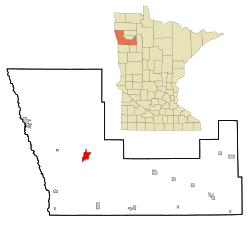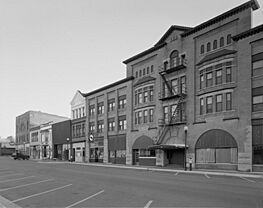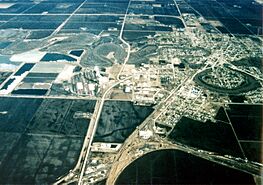Crookston, Minnesota facts for kids
Quick facts for kids
Crookston, Minnesota
|
||
|---|---|---|
|
Crookston Commercial Historic District
Aerial view of Crookston, Minnesota, with the Red Lake River twisting through the town
|
||
|
||

Location of Crookston in Polk County, Minnesota
|
||
| Country | United States | |
| State | Minnesota | |
| County | Polk | |
| Metro | Greater Grand Forks | |
| Settled | 1872 | |
| Organized | 1876 | |
| Incorporated | February 14, 1879 | |
| Government | ||
| • Type | Mayor-council (weak-mayor, strong-council) | |
| Area | ||
| • City | 5.115 sq mi (13.249 km2) | |
| • Land | 5.115 sq mi (13.249 km2) | |
| • Water | 0.000 sq mi (0.000 km2) | |
| • Urban | 4.650 sq mi (12.040 km2) | |
| • Metro | 3,407 sq mi (8,825 km2) | |
| Elevation | 873 ft (266 m) | |
| Population
(2020)
|
||
| • City | 7,482 | |
| • Estimate
(2023)
|
7,268 | |
| • Density | 1,420.87/sq mi (548.61/km2) | |
| • Urban | 7,618 | |
| • Urban density | 1,638.69/sq mi (632.7/km2) | |
| • Metro | 103,120 | |
| • Metro density | 30.3/sq mi (11.69/km2) | |
| Time zone | UTC−6 (Central (CST)) | |
| • Summer (DST) | UTC−5 (CDT) | |
| ZIP Code |
56716
|
|
| Area code(s) | 218 | |
| FIPS code | 27-13870 | |
| GNIS feature ID | 2393678 | |
| Sales tax | 7.375% | |
Crookston is a city in the state of Minnesota, in the United States. It is the main city and county seat of Polk County. In 2020, about 7,482 people lived there. Crookston is part of the larger "Greater Grand Forks" area, which includes parts of North Dakota and Minnesota.
The city is also the home of the Roman Catholic Diocese of Crookston. Many people who live in Crookston travel to the nearby city of Grand Forks, North Dakota for work.
Contents
History of Crookston
Early Times in the Area
For a long time, the area where Crookston now stands was mostly empty. It was used as a hunting ground by different groups of people. These included Ojibwa and Lakota tribes, as well as Métis and early European traders.
This land became part of the United States in 1818. Before that, it was part of a large area called Rupert's Land. Between 1790 and 1870, trappers and traders often passed through this region. A part of the famous Red River Trails also went nearby. These trails were important for the fur trade.
How Crookston Was Settled
People who were not Native American first started settling in Crookston around 1872. By 1876, there was a government office there for land claims. The Great Northern Railway started running trains through the town by 1880.
The town officially became a city on April 1, 1879. It was first called "Queen City." Soon, the people decided they needed a new name. Two groups wanted different names. One group wanted to name it "Davis" after the first mayor, Captain Ellerey C. Davis. The other group wanted "Crookston" to honor Colonel William Crooks. He was a soldier and helped build railroads. They say the name was chosen by a coin toss!
Soon, many immigrants from Scandinavia, France, and Germany moved to Crookston. At one point, eight different railroad lines came to the town. This made Crookston a busy place for business and making goods.
Geography of Crookston
Crookston covers about 5.115 square miles (13.249 square kilometers) of land. There is no water within the city limits.
The city is located in the very rich Red River Valley. This area was once covered by a huge glacial lake called Lake Agassiz. When the lake dried up, it left behind very fertile soil. This soil is perfect for farming. Crops like wheat, sugar beets, and potatoes grow very well here.
Crookston has a mostly flat landscape. The Red Lake River flows through the city. It makes many twists and turns, creating oxbows. The riverbanks have worn away a bit over time.
Several main roads pass through Crookston. These include U.S. Highways 2 and 75. Also, Minnesota State Highways 9 and 102 serve the community.
Crookston is also the start of the Agassiz Recreational Trail. This trail is 53 miles long and is used for many activities. It was built on an old railroad track.
Population Changes
| Historical population | |||
|---|---|---|---|
| Census | Pop. | %± | |
| 1880 | 1,227 | — | |
| 1890 | 3,457 | 181.7% | |
| 1900 | 5,359 | 55.0% | |
| 1910 | 7,559 | 41.1% | |
| 1920 | 6,825 | −9.7% | |
| 1930 | 6,321 | −7.4% | |
| 1940 | 7,161 | 13.3% | |
| 1950 | 7,352 | 2.7% | |
| 1960 | 8,546 | 16.2% | |
| 1970 | 8,312 | −2.7% | |
| 1980 | 8,628 | 3.8% | |
| 1990 | 8,119 | −5.9% | |
| 2000 | 8,192 | 0.9% | |
| 2010 | 7,891 | −3.7% | |
| 2020 | 7,482 | −5.2% | |
| 2023 (est.) | 7,268 | −7.9% | |
| U.S. Decennial Census 2020 Census |
|||
Crookston's population has not grown much since the 1970s. In 2020, the city had 7,482 people. About 20.1% of residents were under 18. Also, 20.8% were 65 or older.
Education in Crookston
Schools for Kids
Crookston is part of the Crookston School District 593. The main high school is Crookston High School, and their sports teams are called the Pirates. Students from nearby towns like Euclid, Gentilly, and Mentor also go to Crookston High. In the 2022–23 school year, about 1,135 students were in K-12 grades.
Before 1997, students went to Central High School downtown. That school had been open since 1913.
There are also private elementary schools in Crookston. These include Cathedral Elementary (a Catholic school), Our Savior's Lutheran, and Bible Baptist.
Higher Education
Crookston is home to the University of Minnesota Crookston. This is a campus of the larger University of Minnesota system. It started as a high school for agriculture. Later, it became a two-year college, and then a four-year university. In 2010, a new Sports Center was opened at the university. About 1,729 students were enrolled there in the fall of 2024.
Media and News
The local newspaper in Crookston is the Crookston Daily Times.
Television
Crookston is part of the TV market for Fargo and Grand Forks. A PBS TV station, KCGE (channel 16), is licensed to Crookston. It serves the Grand Forks area.
Local Radio Stations
KROX 1260 AM is a radio station that specifically covers Crookston. You can also hear it on FM at 105.7. Other radio stations from Grand Forks and Thief River Falls can be heard easily. KRJB 106.5 FM from Ada also reaches Crookston. Two other stations, KQHT 96.1 FM and KYCK 97.1 FM, are licensed to Crookston but broadcast from Grand Forks.
Culture and Fun
Crookston is proud to have the Grand Theater. It is the oldest movie theater in the United States that has been open continuously. It was built in 1910 and first served as an opera house. By 1917, it mostly showed movies. Famous entertainers, like early film actress Mary Pickford, performed there.
Notable People from Crookston
Many interesting people have come from Crookston:
- Dan Anderson, a professional basketball player.
- Joseph H. Ball, who was a U.S. senator for Minnesota.
- John Christgau, an American author.
- Ronald N. Davies, a judge for a U.S. District Court.
- Jules Ellingboe, a racing car driver.
- Philip Hamre, a medical technician and state politician.
- Miner A. Helgeson, a farmer and state politician.
- Leroy E. Matson, a justice on the Minnesota Supreme Court.
- John Noah, an ice hockey player.
- Julius Spokely, a sheriff and state politician.
- Milton Orville Thompson, a NASA astronaut and scientist.
- Theodore W. Thorson, a state politician and teacher.
- Wes Westrum, who played baseball for the New York Giants.
- Ed Widseth, who played football for the New York Giants.
- Harvey A. Wilder, a farmer and state politician.
See also
 In Spanish: Crookston (Minnesota) para niños
In Spanish: Crookston (Minnesota) para niños



